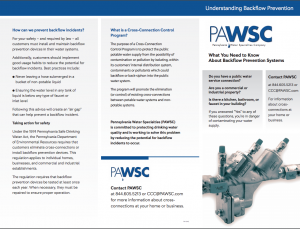In keeping with our pledge to sustain an ongoing investment in our customers, communities and partners to help us all enjoy a cleaner lifestyle – and realize a bright green future, BCSWA is proud to announce that it has joined with Pennsylvania Water Specialties Company (PAWSC) to establish a cross-connection control administration and backflow prevention program for its commercial customers to insure that our relentless focus on quality and accountability provides a proven source of drinking water that you can count on.
The United States Environmental Protection Agency (EPA) and the Department of Environmental Protection (DEP) in Pennsylvania define a “cross-connection” as any point in the water supply system where non-potable, or non-drinkable, water can be introduced to potable or clean sources. All service lines connected to public water systems are therefore potential “cross-connections”.
The Authority’s water distribution system is designed to ensure that water flows from the water main through a service line to the premises of its customers. Certain conditions-such as frozen pipes, a water main break, or even extreme and unexpected demand on the system-can cause water pressure to fail. When that happens, water from customer service lines can flow back into the distribution system, potentially contaminating the local public water supply, and thereby creating a hazardous situation which is commonly referred to as “backflow.” To avoid such dangerous incidents, and as a matter of public safety, federal and state laws require certain customers to install backflow prevention (“BFP”) assemblies on their water services and to test and maintain these assemblies periodically.
Accordingly, BCSWA is responsible for adopting and implementing a Cross-Connection Control (“CCC”) Program for its commercial customers to survey the water distribution system and communicate with customers to determine the existence of cross-connection hazards and to enforce rules for the customers to install BFP assembles and have those assemblies tested on a regular basis.
At no cost to the authority, BCSWA has joined with PAWSC, a knowledgeable provider about state and federal CCC Programs requiring installation, testing and maintenance of BFP assemblies. PAWSC will administer the program which involves the professional day-to-day administration, tracking and record-keeping functions of a properly established CCC Program.
PAWSC will be in contact with those commercial customers who are required to install and properly maintain these BFP devices through letters about the requirement of the program.
Download PAWSC Education HR PDF
Cross-Connection Control – Questions and Answers
What is a Cross Connection?
A cross connection is a physical connection between a possible source of contamination and the public drinking water system. This connection, if not properly protected, can lead to the contamination of the drinking water system through a backflow event. Any service connection is a cross-connection.
What is backflow?
Backflow is the reversal of water flow through a cross connection from a possible source of contamination into the public drinking water system. Backflow may be caused by either backpressure or backsiphonage. A loss of pressure in the public drinking water system may lead to backsiphonage through unprotected cross connections, or backpressure may be created when the water pressure of a facility’s internal water system is elevated above the supply pressure of the public drinking water system resulting in backflow through unprotected cross connections.
What is Backsiphonage?
Backsiphonage occurs when there is a partial vacuum (negative pressure) in a water supply system, which draws the water from a contaminated source into a potable water supply. The water pressure within the distribution system falls below that of the plumbing system it is supplying. The effect is similar to siphoning or drinking water through a straw. For example, during a large fire, a pump is connected to a hydrant. High flows pumped out of the distribution system can result in significantly reduced water pressure around the withdrawal point. A partial vacuum has been created in the system, causing suction of contaminated water into the potable water system. During such conditions, it is possible for water to be withdrawn from nonpotable sources located near the fire — for example, air-conditioning systems, water tanks, boilers, fertilizer tanks and washing machines — into buildings located near a fire. The same conditions can be caused by a water main break.
Garden hoses, toilets or similar devices create most household cross-connections. Under certain conditions, the flow in household water lines can reverse and siphon contaminates into the water supply. A toilet installed incorrectly without a “plumbing-code approved” toilet ballcock (air gap) will allow contaminated water to backflow to other water outlets in your house, including the kitchen sink.
What is a Backflow Prevention Device?
A backflow prevention device is a means or mechanism to prevent backflow. The basic means of preventing backflow is an air gap, which either eliminates a cross-connection or provides a barrier to backflow. The basic mechanism for preventing backflow is a mechanical backflow preventer, which provides a physical barrier to backflow. The principal types of mechanical backflow preventers are the reduced-pressure principle assembly, the pressure vacuum breaker assembly, and the double check valve assembly. A secondary type of mechanical backflow preventer is a dual check valve.
As a Water Customer in BCWSA’s Service Territory; What am I Required to Do?
Some water customers are required to have an approved backflow device installed and tested on an annual basis. These customers must certify to BCWSA that these devices have been maintained and are in working order. This should include a test performed by a qualified technician and a completed backflow prevention device test form submitted to the Cross-Connection Control department.
Who Gives the Authority to Implement the Program?
Authority to enforce Cross-Connection Control comes from Pennsylvania’s Safe Drinking Water Act, the Pennsylvania Code Chapter 109, the Pennsylvania Department of Environmental Protection (PADEP), the International Plumbing Code (IPC) Section 312, and the BCWSA Ordinance.
What Kind of Backflow Device do I Need?
The type of backflow device depends upon the degree of hazard present at your location. The degree of hazard depends on the use of water at your location and what could potentially enter the system. If you are unsure, please contact the Cross-Connection Control department at 1-844.605.5213 to determine the type of device needed at your facility.
Who Should Install & Test a Backflow Device?
While there are no standards set for who can install a backflow prevention device, repairs and tests to backflow preventers must be performed by certified technicians. Technicians testing backflow preventers should be American Society of Sanitary Engineering (ASSE) Series #5110 certified. Technicians repairing backflow preventers should be ASSE Series #5130 certified.
Where should the backflow device be installed?
The backflow device must be installed on the customer’s water service line immediately after the meter and before any branching of the service line.
How Much Does a Backflow Device Cost?
The cost of a backflow device varies based on the size, type and location.
Who is Responsible for Paying for the Device & Testing?
It is the customer’s responsibility to ensure that any contaminants or pollutants do not enter the water distribution system from their location. All costs related to the installation, maintenance and testing are the customers’ responsibility.
Are all Non-Residential Customers Required to Comply?
Yes. All non-residential customers are required to comply. There are no exceptions.
Are residential customers required to have cross-control/backflow prevention measures in place?
Yes. All new construction/new residential service connections are required to have appropriate backflow protection in place before service is provided. Existing customers also must have appropriate backflow protection in place. Most fire sprinklers and lawn sprinklers require a testable backflow prevention device be installed. If you are unsure, please call the Cross-Connection Control Department at 844.605.5213.
What happens if I do not comply?
The water company has the right under the Pennsylvania Code Section 109.709 to shut off your water service until you are in compliance.
Once I have my device tested, where do I submit a completed test form each year?
Test forms will only be accepted from the technician, who has sole responsibility for providing the form to the Cross-Connection Control department. It is not necessary for the customer to submit the test form. Test forms can be submitted online at https://pawsc.tokaytest.com/
What can you do to prevent backflow situations in your home or business?
- Be aware of and eliminate and/or protect cross connections
- Maintain air gaps on sinks and when using hoses
- Do not submerge hoses or place them where they could become submerged
- Use hose bib vacuum breakers on fixtures (hose connections in the basement, laundry room, and on outside faucets/spigots)
- Install approved backflow prevention devices on lawn irrigation systems and on fire sprinkler system services
- Do not create a connection between an auxiliary water system (well, cistern, body of water) and the water supply plumbing
Why should you be concerned?
- Backflow may affect the quality of the drinking water at your facility and has the potential to create health hazards if contaminated water enters your water supply plumbing system and is used for drinking, cooking or bathing
- Unprotected cross-connections with water supply plumbing or public drinking water piping systems are prohibited by law
- You are responsible for protecting your water supply plumbing from backflow that may contaminate your drinking water and the drinking water of others. This includes complying with the plumbing code and not creating unprotected cross connections
- Who is responsible for having the backflow device tested?
It is the responsibility of the property owner to have the backflow device tested by a qualified tester. It is also the responsibility of the property / business owner to schedule their own test appointment.
I have an in ground lawn sprinkler system at my residence. Am I required to have a backflow device and have it tested?
In ground sprinkler systems are required to have a testable backflow prevention device installed on the water line servicing the system. If you are unsure, please contact the Cross-Connection Control department at 844.605.5213 to determine the type of device needed on your system.
I have a fire sprinkler system at my residence. Am I required to have a backflow device and have it tested?
Fire sprinkler systems connected to the public water supply are required to have either a reduced pressure zone (RPZ) backflow preventer or a double check (DC) backflow prevention device installed on the water line servicing the system. The type of device needed will depend on the type of fire sprinkler system in the residence. If you are unsure, please contact the Cross-Connection Control department at 844.605.5213 to determine the type of device needed on your system.
I received a survey on my water usage at my facility. What is this about?
BCWSA conducts periodic surveys of their customers’ use of water to identify and eliminate possible sources of cross connections to help ensure the safety of the public water supply. The information collected through the surveys helps to identify where backflow prevention devices may be needed as well as providing information on existing devices that may not have been previously submitted to the water company.

